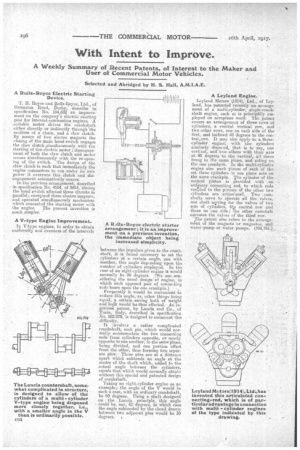With Intent to Improve.
Page 24

If you've noticed an error in this article please click here to report it so we can fix it.
A Weekly Summary of Recent Patents, of Interest to the Maker and User of Commercial Motor Vehicles.
Selected and Abridged by H. S. Hail, A.M.I.A.E.
A Rolls-Royce Electric Starting Device.
T. H. Royce and Rolls-Royce, Ltd., of Osmaston Read, barley, describe in specification No. 104,602 an improvement on the company's electric starting gear for internal-combustion engines. A suitable motor 'drives the crankshaft either directly or indirectly through the medium of is chain, and a claw clutch. By means of two electro magnets the closing of the main hand-switch engages the claw clutch ,simultaneously with the starting of the electric motor ; disengagement of both the claw clutch and meter occurs simultaneously with the re-opening of the switch. The design, of the claw clutch is such that immediately the engine commerrcee to run under its own power it overruns this clutch and disengagement automatically ensues. In the previous arrangement, described in specification No. 4054, of 1915, closing the hand switch affected three circuits in parallel.; energized three electro magnets, and operated simultaneously mechanism which connected the starting motor. with
the engine. The present invention is much simpler.
A V-type Engine Improvement.
In V-type engines, in order to obtain uniformity and evenness of the intervals
"between the impulses given to the crankshaft, it is found necessary to set the cylinders at a certain angle, one with another, this angle .depending upon the number of cylinders employed. In the' case of an eight-cylinder engine it would normally be 90 degrees. (We are -considering the usual designof engine, in which each opposed pair 'of connecting re ds bears upon the one crankpin.)
Frequently it would be convenient to reduce this angle, as, other thins being equal, a certain saving both of weight and bulk would be thus effected. An ingenious patent, by Lancia and CO., of Turin, Italy, described in specification No. 102,378; is designed to surmount this difficulty.
It involves a rather complicated crankshaft, each pin, which would normally accommodate the two connecting rods from cylinders opposite, or nearly opposite to one another, in the same plane, being divided, and one portion offset from the other, thus forming two seller • ate pins.. These pine are at a distance. apart which subtends an angle at the centre of the shaft which, added to the actual angle between the cylinders, equals that which would normally obtain without this special and patented design of crankshaft.
Taking an eight-cylinder engine as an example; the angle of the V would in such a case, with an ordinary crankshaft, be 90 degrees. Using a shaft designed on the Lancia principle, this angle could be, say, 60 degrees, in which case the angle subtended by the chord drawn between two adjacent pine would be 30 degrees. o
A Leyland Engine.
Leyland Motors {19l4), Ltd., of Leyland, has patented recently an arrangement of a niphieiylinder, single-crankshaft engine, such as is principally employed on aeroplane work_ The patent covers an arrangement of three rows of cylinders, a central Vertical row, and two -other rows, one on each si:de of the first; and inclined 40 degrees to the central,one. It may eke apply to a threecinder engine; with the cylinders similarly dispoeecl, that is to say, one vertical, and two others with their axis at 40 degrees to the vertical, all three being in the same plane, and acting on the one crankpin. In the multi-cylinder engine also each piston of each of the set three cylinders in one plane acts on the same crankpin. The cylinder of the central piston is provided with an ordinary cennecting rod., to which rods con'eled to the p'stons of the other two cylinders are articulated. Two .careshafts serve to operate all the valves, one shaft serVing for the valves of two sets ot cylinders, the central .row and those on one side; the other eamshaft operates the valves ei the third row.
The patent also refers to the arrangement of the magneto or magnetos, and water pump or water pumps. (104,761.)
























